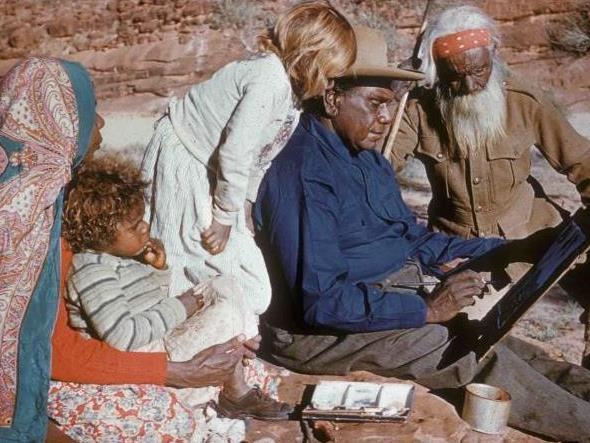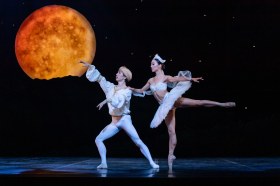Albert Namatjira with his wife Rubina, grandchildren and father Jonathon. Photo: Pastor S.O. Gross, courtesy of Strehlow Research Centre
Two films about two iconic Australian artists have been released in near as many months. Almost 60 years after Albert Namatjira’s death after being wrongly imprisoned, and 25 years after Brett Whiteley died in a Thirroul hotel from an overdose, their stories are being told on the big screen.
Namatjira Project, directed by Sera Davies and distributed by Umbrella Entertainment, was premiered at the Brisbane International Film Festival on 29 August and released nationally on 7 September.
Whiteley, directed by James Bogle and written by Bogle and Victor Gentile, was released in May 2017, and can already be purchased from gallery giftshops.
Couched in the genre of documentary – or what is called a biopic in the filmic world (a biographical film) – both films reach beyond mere story telling. Running alongside the marketing of Whiteley is the hashtage #ArtIsARealJob, while all promotion for Namatjira Project is accompanied with the line, ‘to support the cause you can donate to the Namatjira Trust.’
It is a rather different tone than the kind of Hollywood roll-out that we have seen with other feature films on the lives of artists – your Frida, Basquiat, Pollock, Fur, Girl with the Pearl Earing and Surviving Picasso – all big production, big name films that aimed at big box office results.
Arguably, Australia has been relatively slow picking up on the international trend of exposing artists on the big screen. One might wonder why, given the mythical life of the artist can be fleshed out in all its sordid details – sex, drugs and toxic paint fumes. It is the kind of material that gives texture to any good film, if written well. Sirens, inspired by the life of Norman Lindsay, written and directed by John Duigan, produced by Sue Millikan and released in 1994 is a rare example. It made nearly $3m in Australia and $7.7m in the US.
But these two new additions find their own place. They are stories told, long overdue. But are Australian audiences watching, or worse still interested? Arts content has been growing with the introduction of digital television and dedicated programs on the ABC and SBS, not to mention the growing volume of content produced by individual cultural oganisations. It is attempt to normalise and better embed culture in our everyday lives. Perhaps the silver screen is the next obvious step?
More than a film
Seven years in the making, and in the wake of 14-years of copyright injustice, the Namatjira Project is an attempt to document ‘the commercial appropriation of Aboriginal experience,’ says Director Sera Davies.
From the outset this film isn’t a straight doco, or recounting of Namatjira’s life, but a kind of pitch or placard to reclaim the copyright of Namatjira’s work on behalf of his family.
The film moves between interviews and archival material, from Namatjira’s country to Buckingham Palace, then stitches in footage from the play Namatjira performed at Sydney’s Belvoir Theatre as a way of first-person storytelling.
Ironically Albert Namatjira was the first Indigenous person to be made a citizen by the Australian Government, and yet in 1983 the Government sold the copyright to his entire catalogue of artworks to an art dealer. To this day, his descendants receive no royalties – a figure the filmmakers estimate more than $10 million in 2012. They were sold in 1983 for a mere $8500.
SMH explains: ‘Before his death, Albert Namatjira had signed a deal with John Brackenreg, owner of Legend Press in Sydney, granting sole rights to reproduce his paintings in return for a 12.5 per cent royalty. Namatjira died without a will, so his assets were managed by the Public Trustee of the Northern Territory until 1983, when the trustee sold the rights outright to Legend Press.’
Namatjira’s copyright will expire in 2029. This year, the Public Trustee, who oversaw the sale of Namatjira’s copyright, admitted wrongdoing.
This is the power of documentary films – the kind of expose for action made popular by films such as Davis Guggenheim’s An Inconvenient Truth (2006), the films of Mike Moore, and most recently artist Ai Weiwei’s tale of the global refugee exodus, Human Flow, that has been picked up by mega company Lionsgate with its screening at the Carnes Film Festival.
While Namatjira Project is a long way from Cannes, it is hoped this human-interest-art-story-come-protest will swell public opinion and encourage change.
The title, Namatjira Project, comes from the overall structure that produced the film – a collaboration between social change organisation Big hArt and the families of Namatjira and Rex Battarbee, the white Australian artist who taught Albert how to use watercolours in the 1930s.
SMH film critic adds: ‘Part of what makes the film so powerful is the sense of collaboration and generosity. The Namatjira family members grant enormous trust to the filmmakers.’

Australia’s Basquiat within the box office
In 1996, it was a film on the American artist Basquiat, directed by fellow artist Julian Schnabel, that set a new tone for the artist feature film. In some ways, Whiteley has the same sort of sex, drugs, celebrity and good art recipe to be a hit.
Basquiat opened in 6 venues earning $83,863 in its first weekend. The film ultimately grossed $3,011,195 domestically in the US – so by all conventions it remained a boutique art film.
Told largely in Whiteley’s “own words” using personal letters, notebooks and photographs, interwoven with reconstructions, animations, archival interviews, audio recordings from the artist himself and rare footage – most of which has been supplied by Whiteley’s widow Wendy.
From the heady days of the living at the Chelsea Hotel in New York to being deported from Fiji for the possession of drugs, this is a tale that crosses continents, weaves tales behind his iconic canvases and plays out the artist-genius to mythic proportions.
Like Namatjira Project, director James Bogle, also turns to outside sources to add authority, voice and texture to his doco, but rather than theatre it is footage from a 1983 60 Minutes profile and a 1988 documentary, Difficult Pleasure, by Don Featherstone.
An oddity is Bogle’s decision to use actors in a series of dramatic reconstructions to fill in the gaps, sitting awkwardly with the archival material. Some have criticised the film for not having the freedom to tell the full story, fiercely overlooked by Wendy Whiteley, who is sole custodian of his legacy.
Despite the opinion, Whiteley’s time on the silver screen was due. He was 22 when the Tate bought one of his abstracts in the early 1960s, and his impact on Australia’s creative culture has been an incredible legacy. The Herald Sun critic’s verdict is that this is a film that paints Whiteley out of a box and into a corner.
Whiteley was Produced by Sue Clothier; Director of Photography Jim Frater and Editor Lawrie Silverstrin.
Whiteley was released by Transmission Films, the same company that released the documentary The Bansky Job last year, which explored the infamous theft of street artist Banksy’s sculpture, ‘The Drinker’ and the ensuing battle with the art terrorist: AK47.
Top six films about artists
While it’s debatable whether a film can ever truly convey an artist’s creative process, there have been many great movies made about artists who paint. Here is our pick of the top five biopics, and then all the others you can watch.
1. Basquiat (1996)
Directed by Julian Schnabel, released by Miramax, it chronicles the life of New York-based painter and musician Jean-Michel Basquiat, from his evolution as a graffiti artist to celebrated art star, and eventual overdose in 1988.
2. Frida (2002)
Winning two Oscars for Best Music Original Score and Best Makeup – and an Academy nomination for Salma Hayek for Best Actress – Frida did pretty well at the box office. Against a budget of $12m, to which we have to add a substantial advertising spend, the film made nearly $60m around the world. Directed by Julie Taymor, Frida also features Mia Maestro, Antonio Banderas, Geoffrey Rush, Valeria Golino, Ashley Judd, Roger Rees, and Edward Norton.
3. Pollock (2000)
I was lucky to catch the premier of this movie in the States, rubbing red carpet shoulders with Ed Harris and Marcia Gay Harden. Did that make it that much better to watch? It depicts the turbulent marriage between Jackson Pollock and fellow painter Lee Krasner, up to his tragic death in a car accident in 1956. Harden earned an Oscar for Best Actress in a Supporting Role, while Harris was nominated for Best Actor in Leading Role. Directed by Harris.
4. Fur: An Imaginary Portrait of Diane Arbus (2006)
Staring Nicole Kidman and Robert Downey Jr, and directed by Steven Shainberg, this is your typical Hollywood take on an artist, exaggerating and fictionalising the life of American photographer Diane Arbus. No pictures by Arbus herself are featured in it either, because the Diane Arbus estate refused to give approval.
5. Surviving Picasso (1996)
Staring Anthony Hopkins and Julianne Moore, and directed by James Ivory – one half of the Merchant Ivory duo – tells the story of Francoise Gilot, the only lover of Pablo Picasso, who was strong enough to withstand his ferocious cruelty.
6. Girl with a Pearl Earring (2003)
Perhaps, one of the most successful films about artists, it earned a worldwide gross of $31m, from a budget of $14m. It is the story of a young peasant maid working in the house of painter Johannes Vermeer who becomes his talented assistant and the model for one of his most famous works. Directed by Peter Webber and starring Scarlett Johansson, Colin Firth, Tom Wilkinson and Judy Parfitt.
Others released
What is a curious anomaly, is that while our general media streams seem to find little interest or a challenge in reporting the arts, Hollywood has been throwing money at films about artists as early as the 1930s. And, the fact that they have consistently been made to this day, would suggest that publics are indeed interested.
This is the list we could dig up:
Rembrandt (1936)
Lust for Life (1956) – Film about Vincent can Gogh directed by Vincente Minnelli, which takes a particular look at his relationship with his art dealer brother, Theo. Staring Kirk Douglas in the lead role. The film garnered three Academy Award nominations and a Best Actor in a Supporting Role Oscar for Anthony Quinn, who has a minor role as fellow artist Paul Gaugin.
Michelangelo (1965) – Michelangelo
The Agony and the Ecstasy (1965) – Based on a biographical novel of the same name by Irving Stone, this Carol Reed-directed film depicts the contentious relationship between Michelangelo and Pope Julius II while painting the Sistine Chapel. Michelangelo was played by Charlton Heston, while Pope Julius II by Rex Harrison. Although the film was considered a commercial failure at the time of its release, it was acclaimed by the critics and garnered five Academy Award nominations.
Andrey Rublyov (1966) – Andrey Rublyov
Russian director Andrei Tarkovsky tackled a biopic of fifteenth-century icon painter Andrei Rublev in a climate of political and religious conflicts of the day. Created in 1966, the film premiered at the 1969 Cannes Film Festival where it earned Tarkovsky the FIPRESCI Prize.
Edvard Munch (1974) – Taking a docu-drama approach, director Peter Watkins takes a look at Norwegian painter Edvard Munch. Swedish director Ingmar Bergman purported called the film a “masterpiece.”
Caravaggio (1986) – by the challenging high art director Derek Jarman. Tilda Swinton’s first film role.
Camille Claudel (1988) – Director Bruno Nuytten takes a look at the sister of writer Paul Claudel and muse of famous sculptor Auguste Rodin. Stars Isabelle Adjani and Gérard Depardieu
All the Vermeers in New York (1990) – Director: Jon Jost
Vincent & Theo (1990) – Vincent van Gogh
Van Gogh (1991) – Director Maurice Pialat examines the final sixty-seven days of Van Gogh’s life
Carrington (1995) – Director Christopher Hampton looks at the platonic relationship between artist Dora Carrington and writer Lytton Strachey. Stars Emma Thompson and Jonathan Pryce.
Surviving Picasso (1996)
Basquiat (1996)
Goya In Bordeaux (1999) – a film about Francisco Goya
Pollock (2000)
Frida (2002)
Chi-hwa-seon aka Painted Fire (2003)
Girl with a Pearl Earring (2003) – life in the house of Johannes Vermeer
Modigliani (2004)
Klimt (2006) – A portrait of Austrian artist Gustav Klimt, whose lavish, sexual paintings came to symbolize the art nouveau style of the late nineteenth and early twentieth century. Directed Raúl Ruiz and starts John Malkovich as Klimt.
Factory Girl (2006) – Based on the rise and fall of socialite Edie Sedgwick, and her relationship with Andy Warhol. Director by George Hickenlooper and staring Sienna Miller and Guy Pearce.
Fur: An Imaginary Portrait of Diane Arbus (2006)
El Greco (2007)
Caravaggio (2007 TV Movie)
Little Ashes (2008) – The story of Salvador Dali
Séraphine (2008) – Séraphine dominated France’s prestigious César Awards in 2009 with seven wins, including the award for Best Film.
Renoir (2012) – Set on the French Riviera in the summer of 1915, it is directed by Gilles Bourdos.
Shirley (2013) – A film about Edward Hopper
Big Eyes (2014) – The story of painter Margaret Keane, and the subsequent legal difficulties she had with her husband, who claimed credit for her works in the 1960s. Directed by Tim Burton and staring Amy Adams.
Camille Claudel 1915 (2013) – Confined by her family to an asylum in the South of France – where she will never sculpt again – the film chronicles Camille Claudel’s reclusive life, as she waits for a visit from her brother, Paul Claudel. Director by Bruno Dumont it stars Juliette Binoche and Jean-Luc Vincent.
Mr. Turner (2014) – Exploring the life of J. M. W. Turner, who is widely considered one of Great Britain’s greatest painters, it is directed by Mike Leigh and staring Timothy Spall. The film premiered at the 2014 Cannes Film Festival, where it secured multiple honors, including a Best Actor Award for Spall. Mr. Turner was also one of the films that was leaked in the aftermath of the hacking attack on Sony Pictures’ computer systems, reports Forbes.





